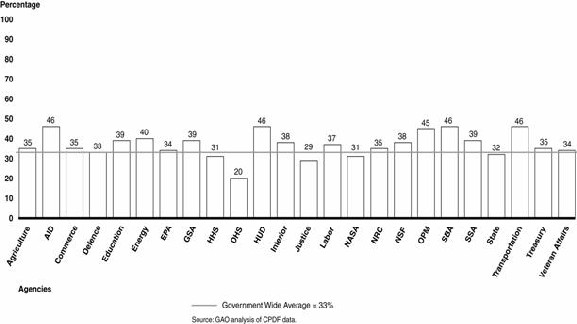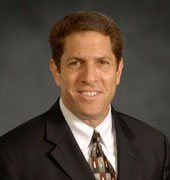Human Capital Management
The nation faces new and more complex challenges in the 21st century including a large and growing long-term fiscal imbalance, evolving national and homeland security threats, increasing global interdependence, and the need to rethink relevant regulatory oversight structures in light of the turmoil in worldwide financial markets.
To help address these challenges, federal agencies will need to transform themselves to plan more strategically, react more expeditiously, and focus on achieving results. Critical to the success of this transformation are agencies' employees and effective human capital management programs.
Highlights of GAO-05-1048T (PDF), Highlights of GAO-07-556T (PDF)
Agencies are also facing a looming retirement wave. As shown in figure 1, government-wide, about one-third of federal employees on board at the end of fiscal year 2007 will become eligible to retire by 2012, but at some agencies, the potential retirement wave could be larger. As experienced employees retire, they leave behind critical gaps in leadership and institutional knowledge, which could adversely affect the government's ability to carry out its diverse responsibilities and missions and effectively respond to urgent national issues. The Department of the Treasury, for example, as a result of legislation enacted in October, 2008, has the monumental task of managing and overseeing the government's efforts to stabilize the nation's financial system and restore the functioning of the nation's credit markets. However, 35 percent of its employees who were on-board at the end of fiscal year 2007 will be eligible to retire by 2012.
Figure 1: Percentage of Career Federal Employees Eligible to Retire by 2012

- In 2001, we identified federal human capital management as a government-wide
high-risk area because human capital shortfalls were eroding the ability
of many agencies—and threatening the ability of others—to effectively,
efficiently, and economically perform their missions. Although improvements
have been made over the last few years, additional efforts are needed across
a range of human capital activities.
Full Report of GAO-01-263 (PDF, 213 pages), Highlights of GAO-07-556T (PDF)
- One such activity is human capital planning, where agencies will need to
strengthen their efforts to help ensure they have the talent needed to address
current and future challenges. At the Department of Transportation, for example,
we noted that effective human capital planning will be essential for the
agency to address workforce gaps and bolster future organizational capacity.
Highlights of GAO-04-39 (PDF), Highlights of GAO-07-556T, Highlights of GAO-08-762T (PDF)
- Effective human capital planning efforts are also needed to address demographic
trends facing the government, including the diversity of the senior executive
service (SES) and the potential SES developmental pool (GS-15s and GS-14s).
Highlights of GAO-05-90 (PDF)
- Agencies will also need to improve how they acquire, develop, and retain
talent. For example, in our prior work, we noted that a shortage of individuals
with specific foreign language skills was undermining the State Department's
ability to execute critical duties. Likewise, the Federal Aviation Administration
will need to continue hiring and training thousands of air traffic controllers
over the next decade to replace controllers who are retiring or leaving for
other reasons.
Highlights of GAO-06-894 (PDF), Highlights of GAO-07-556T (PDF), Highlights of GAO-08-908T (PDF)
- Further, while it is important for agencies to build a results-oriented
culture by, among other actions developing a performance management system
that links individual performance with organizational outcomes, such a system
has proved difficult for agencies to implement. For example, we reported
that the Department of Defense needs to ensure that its performance management
system contain appropriate internal safeguards, such as reasonable transparency,
to help enhance the system’s fairness and credibility.
Highlights of GAO-03-488 (PDF), Highlights of GAO-08-773 (PDF), GAO-06-582R (PDF)
- The Office of Personnel Management (OPM) and Congress have supported a number of noteworthy human capital reforms. For example, OPM has developed online decision support tools to provide agencies with guidance on how to use hiring flexibilities and retention strategies. Congress has provided agencies with hiring flexibilities that could help streamline the hiring process.
^ Back to topWhat Needs to Be Done
Highlights of GAO-07-556T (PDF)
- Provide accountable, committed, consistent, and sustained senior leadership attention to address human capital issues.
- Conduct effective strategic human capital planning to help ensure agencies have the right mix of skills to address current and emerging mission requirements.
- Ensure that effective diversity management strategies are in place to provide accountability, fairness, and foster an inclusive workforce.
- Streamline the hiring process by ensuring agencies make full use of available personnel flexibilities.
- Develop a results-oriented organizational culture by creating a "line of sight" between individual performance and the achievement of organizational outcomes.
Highlights of GAO-08-11 (PDF)
^ Back to topKey Reports
- Human Capital: Key Principles for Effective Strategic Workforce Planning
- GAO-04-39, December 11, 2003
- Summary (HTML) Highlights Page (PDF) Full Report (PDF, 38 pages) Accessible Text
- Diversity Management: Expert-Identified Leading Practices and Agency Examples
- GAO-05-90, January 14, 2005
- Summary (HTML) Highlights Page (PDF) Full Report (PDF, 47 pages) Accessible Text
- Human Capital: Increasing Agencies' Use of New Hiring Flexibilities
- GAO-04-959T, July 13, 2004
- Summary (HTML) Highlights Page (PDF) Full Report (PDF, 17 pages) Accessible Text
- Results-Oriented Cultures: Creating a Clear Linkage between Individual Performance and Organizational Success
- GAO-03-488, March 14, 2003
- Summary (HTML) Highlights Page (PDF) Full Report (PDF, 40 pages) Accessible Text
- Human Capital: Federal Workforce Challenges in the 21st Century
- GAO-07-556T, March 6, 2007
- Summary (HTML) Highlights Page (PDF) Full Report (PDF, 15 pages) Accessible Text
- Human Capital: Transforming Federal Recruiting and Hiring Efforts
- GAO-08-762T, May 8, 2008
- Summary (HTML) Highlights Page (PDF) Full Report (PDF, 17 pages) Accessible Text
- Office of Personnel Management: Opportunities Exist to Build on Recent Progress in Internal Human Capital Capacity
- GAO-08-11, October 31, 2007
- Summary (HTML) Highlights Page (PDF) Full Report (PDF, 53 pages) Accessible Text Recommendations (HTML)
- Human Capital: Designing and Managing Market-Based and More Performance-Oriented Pay Systems
- GAO-05-1048T, September 27, 2005
- Summary (HTML) Highlights Page (PDF) Full Report (PDF, 23 pages) Accessible Text


